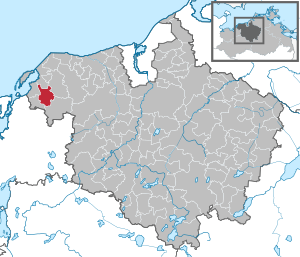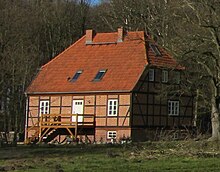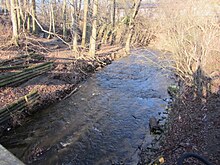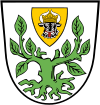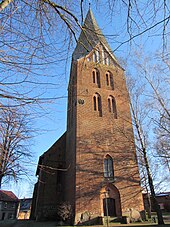Neubukow
| coat of arms | Germany map | |
|---|---|---|

|
Coordinates: 54 ° 2 ′ N , 11 ° 40 ′ E |
|
| Basic data | ||
| State : | Mecklenburg-Western Pomerania | |
| District : | Rostock | |
| Height : | 15 m above sea level NHN | |
| Area : | 25.12 km 2 | |
| Resident: | 3937 (Dec. 31, 2020) | |
| Population density : | 157 inhabitants per km 2 | |
| Postal code : | 18233 | |
| Area code : | 038294 | |
| License plate : | LRO, BÜZ, DBR, GÜ, ROS, TET | |
| Community key : | 13 0 72 074 | |
| LOCODE : | DE NUW | |
City administration address : |
Am Markt 1 18233 Neubukow |
|
| Website : | ||
| Mayor : | Roland Dethloff | |
| Location of the city of Neubukow in the Rostock district | ||
Neubukow is an office-free small town in the northwest of the Rostock district in Mecklenburg-Western Pomerania (Germany). It is the seat of the office of Neubukow-Salzhaff , to which six municipalities belong, but is not itself an official. The place forms a basic center for its surroundings . Since August 2021, Neubukow officially bears the suffix "Schliemannstadt".
geography
Geographical location
The city is located between the Hanseatic cities of Wismar and Rostock , about eleven kilometers from the Baltic coast near Rerik .
City structure
The following parts of the municipality belong to Neubukow:
|
|
story
Surname
The original name Bukow comes from the Old Polish bukov and buk and means beech . It was not until 1260 that the place was designated as novum oppidum bukow (new city of Bukow) and in 1270 as Nova Buchowe . The addition novum was missing later when the place Bucoywe (1278) and Bucowe (1304) were mentioned. In 1395 Nyen Bukowe was written again, which in the course of time changed to Neubukow. Altbukow , a village west of Neubukow, wrote itself Bucoywe in 1281 .
middle age
There was a Slavic settlement in the 12th and 13th centuries . The city was founded in the middle of the 13th century near the nearby Bukow Castle by German new settlers. It was on the road from Rostock to Wismar . In 1192 the parish (old) Bukow was mentioned and in 1246 a Heinricus de Bukowe. In 1260 the city was first mentioned in a document as nouo opido Bukow . Like some cities that were founded in Mecklenburg at this time, the city was laid out with an almost right-angled, grid-shaped road network, a central market with a town hall and a city fortification with originally four city gates .
The construction of the Gothic three-aisled parish church as a hall church began after the middle of the 13th century. The tower is probably from the 15th century. The oldest written evidence of the watermill dates from 1304. Three members of the von der Lühe auf Panzow family founded a vicarie in the church in 1326 , which said that a certain priest at a certain altar on a certain day a mass for the salvation of the family members have to read. The vicarie received income from Lischow. Neubukow became a country town in Mecklenburg and was represented on state parliaments as part of the towns of the Mecklenburg District until 1918 .
The first pastor of the new teaching after the Reformation was Georg Freudenberg, he was appointed in 1549 and stayed in the community until 1594. In 1594, the Sternberg state parliament decided to raise the Lutheran confession to the regional church.
1700 to 1900
There has been a pharmacy in the city since 1709. In 1788 the two-storey, simple baroque town hall with its mansard roof and the central gable was built.
From May 1814 to April 1823 Ernst (Johann Adolf) Schliemann, Heinrich Schliemann's father, was pastor in Neubukow. The first train reached Neubukow on December 22, 1883, and the Neubukow beet railway opened on October 6, 1890 . At that time Neubukow had almost 2000 inhabitants. At the end of the 19th century, Germany's first plaster bandage factory was founded by A. Moratzky. Production was then discontinued in the 1950s.
At the beginning of the 19th century, Jews settled in the village and built a Jewish cemetery on Wismarschen Strasse in 1840 . In the time of National Socialism in 1934 it was desecrated, in 1964 in GDR times a memorial was created from the remains, to which a memorial plaque was added in 1983.
Modern times
During the Second World War , prisoners of war and numerous women and men from countries occupied by Germany had to do forced labor , including perform at the Deutsche Reichsbahn . In 1942 a barrack camp was built for these forced laborers not far from Schützenplatz.
On May 2, 1945, the Red Army moved into Neubukow and took over the place, several houses and apartments were looted. Before the capitulation on May 8, 1945, the place had around 2,000 inhabitants. Afterwards, displaced persons and refugees moved through the country looking for accommodation. The population increased by about double. After the land reform, many of these immigrants were given land and settled. The lack of living space was a problem, every available chamber was used. The original problem of unemployment was partially solved by rebuilding the shipyards in Wismar, where around 2,000 people were already working at the Mathias Thesen shipyard in 1947 .
The city center and the town hall from 1788 have been fundamentally renovated since 1991 as part of the urban development subsidy.
From 1952 to 2011 Neubukow belonged to the Bad Doberan district (until 1990 in the GDR district of Rostock , 1990–2011 in the state of Mecklenburg-Western Pomerania ). The city has been in the Rostock district since 2011 .
History of the districts
Bush mills
Buschmühlen and Drüschow were goods. Drüschow was first mentioned in a document in 1219 and Buschmühlen in 1305. A total of 38 farmers belonged to both estates. In the goods directory of 1921, the goods are named as fiefdoms with a size of 434 hectares, of which 370 hectares were gardens and fields. As a knightly estate, Buschmühlen was the main estate in the community; it was owned by the von der Lühe family , who also owned Rakow, Spriehusen, Teßmannsdorf, Drüschow, Steinbrink and Klein-Strömkendorf.
Malpendorf
The current district used to be an estate southeast of Neubukow. Formerly, for the area Kopfweiden characteristic, 1891 968 pastures were counted, of which still rotten residues are partly preserved. In Niekammer's address book from 1921, Malpendorf is mentioned as a dominal property, it had a size of 240 hectares. 205 hectares were used as gardens and fields, 15 hectares as pastures and 7 hectares as courtyards, paths and the surrounding area. At that time 30 horses, 90 cattle and 20 pigs were kept in the estate. It was the smallest of the estates bordering on Neubukow, and as part of the domanium it has always been a domain owned by the sovereign. Malpendorf was mentioned for the first time in 1219 in a document in which the women's monastery of St. Maria im Sonnenkamp was awarded land, mill yield and fishing. A mill was mentioned in a document in 1304. Malpendorf was called Malbodendorf in 1219, which means place of Malbodo. According to entries in old church files, the property used to be an official building yard, i.e. an institution of the office. In 1850 Malpendorf had 70 residents, 21 of whom were children, nine of whom were of school age. In 1945 there was a report on the school situation: “Malpendorf has always attended the city school. Legally, efforts should be made to place rural children in rural schools ”. During the GDR era, the farm became part of the Hellbach agricultural cooperative; remains of the original facility can still be seen.
Panzov
Panzow was mentioned in a document in 1295, it is not certain whether the place Pancouiz in terra Ylowe mentioned in 1171, 1191 and 1211 is identical to today's Panzow. In 1295 the place was called Pantzow, the name is of Slavic origin, it means place of Pac. In 1427 the place in the Bukow office belonged to Herrmann and Hanneke von Lüthe as a knighthood. In 1544 there lived 18 farmers or kätner in Panzow, one place was described as desolate. In the 16th century, the knightly land still comprised the old court hooves. In the first half of the 19th century, the residents of Langendorf and a part of Einhusen were added, both districts later fell desolate. Einhusen was where the field name Africa , an area planted with poplars, is today. Langendorf was south of the Kuhberg in the Langendorfer paddocks. Around 1782, according to information in church files, Panzow went bankrupt and was then leased as a domain. The former manor was located on a castle wall, which is now a listed building; the complex was surrounded by a system of ditches that was fed by the Hellbach. The courtyard was accessed by several bridges, including a drawbridge, which, like the entire courtyard, fell into disrepair in the middle of the 18th century. The later manor house also stood at this point, it was destroyed by fire in 1949 and then converted into apartments for resettled families. The character of the manor was not preserved.
Spriehusen
Spriehusen was a feud mentioned in 1390 for the first time and in the tradition called field Spriehuser. In a church file from 1653 there is a designation as a courtyard, which, however, has little meaning behind Buschmühlen, the main estate. In 1774 the von der Lühe family gave the farm to the von Osten family . Landowners were then the families Franz Stanislaus Julius, Baron von Seld († 1793) and heirs (from 1784), von Kleist (from 1800), von Voss (from 1805), Crelinger (from 1812), von Post (from 1820), Heinrichsen (from 1827) and Nölting (1835–1948). The manor house, renovated after 2000, dates from 1852.
Incorporations
On July 1, 1950, the previously independent communities Buschmühlen, Malpendorf and Panzow were incorporated.
population
- For 1558, 46 inhabitants are recorded by name in the land register.
- The population in the first half of the 16th century is likely to have been between 200 and 300 people. Of these, 15 were farmers, 23 merchants, blacksmiths, tailors, shoemakers, carpenters and linen weavers.
- In 1580 there were 11 large peasants, 3 small peasants and 33 common citizens and displeased people .
- In the Thirty Years War the population fell by about a third, according to a report by Mayor Christian Wüsthoff, countries were completely burned down, weathered like that ... and there were residents and over 300 citizens lived here ... But now this town is not inhabited with the third part . The bailiff from Bibow confirmed this information.
- In 1653, 358 people lived in the village, 128 of them were children.
- In 1795 the consequences of the Thirty Years' War were overcome, there were 637 inhabitants.
- In 1812 there were 800 residents
- For 1821 there are 1241 inhabitants in the files.
|
|
As of December 31 of the respective year
politics
City council
The city council of Neubukow consists of 15 members and the mayor. Since the local elections on May 26, 2019 , the seats have been distributed as follows:
| Party / list | Seats |
|---|---|
| CDU | 6th |
| SPD | 3 |
| The left | 3 |
| Bürgerbund Neubukow | 3 |
Mayor
- since 2009: Roland Dethloff (independent)
Dethloff was elected in the mayoral election on April 22, 2018 with 80.7% of the valid votes for a further nine-year term.
badges and flags
- coat of arms
The coat of arms was established on April 10, 1858 by Friedrich Franz II, Grand Duke of Mecklenburg-Schwerin and registered under number 80 of the coat of arms of Mecklenburg-Western Pomerania.
Blazon : “A torn green beech in silver; between the two branches a golden shield, in it a looking, gold crowned black bull's head with a wide open mouth, silver teeth, a knocked out red tongue, neck fur torn off in seven points and silver horns. "
- flag
The city's flag is cross-striped green-silver (white) -green (1: 3: 1), in the middle of the silver (white) stripe the figures of the city's coat of arms, a torn green beech, between the two branches a golden (yellow) Shield with the crowned black, red-tongued and silver-horned Mecklenburg bull's head, the height of the figures 7: 9 being the width of the flag, their width 2: 5 being the length of the flag. The length of the flag is related to the height as 5: 3.
Town twinning
The town twinning between Neubukow and Steinfurt in North Rhine-Westphalia has existed since October 24, 1990. In 1991 a town twinning with Reinfeld in Schleswig-Holstein was concluded.
Attractions
- City church Neubukow , Romanesque - Gothic , three-aisled , two-bay hall church made of brick from the 13th century with a retracted, rectangular choir and 52 m high west tower from the 15th century (previously sea mark), renovations in 1858 and 1950, pulpit with carvings (figures of the evangelists ) from 1700
- Town hall, baroque plastered building from 1788 with gable and mansard roof
- Heinrich Schliemann memorial with an exhibition about the life and scientific work of Heinrich Schliemann
- Stele between church and rectory. The sculptor Rainer Kessel created a stele on the 100th anniversary of Schliemann's death in 1990, which commemorates the excavations in Troy
- Memorial plaque on the successor building to Heinrich Schliemann's birthplace in Mühlenstrasse (today's rectory, built in 1894/95)
- Gallery Dutch windmill north-west of the city (built in 1910), functional wing system with bilausch venticants for speed and power control of the windmill. Only a few mills in Germany still have such vented edges on the blades. With a wingspan of 24 m, the mill is the highest of its type. Flour production was stopped in 1991.
- Fish ladder on the Mühlenbach, allows insight into the spawning migration of the fish of the Hellbach
- Former Jewish cemetery on Wismarschen Strasse with a plaque from 1983 to commemorate its destruction and restoration
- OdF memorial from 1950
- Memorial stone for those who fell in the Franco-German War
- Memorial to the fallen of the First World War
- Watermill, first mentioned in 1304, previously leased as an official mill. A turbine with an output of 65 hp was installed in 1905, and another was added in 1919. The mill, previously owned by the family, was nationalized in 1960, it generated around 320,000 kWh, the mill system has been completely preserved and is now in operation in the museum.
- Manor house Spriehusen, neo-Gothic , renovated, ten-axis plastered building from 1852 (reconstruction) with a central projectile and high basement
Economy and Infrastructure
company
Car dealers and handicraft businesses are located in the Berghausen industrial park.
traffic
Neubukow is located on Bundesstraße 105 (built from 1842 to 1847) between Wismar and Bad Doberan . The closest motorway junctions are Kritzow on the A 14 (Wismar - Schwerin ) and Kröpelin on the A 20 ( Lübeck - Rostock ).
Neubukow station is on the Wismar – Rostock railway line . It is served by the regional train line RB 11 ( Wismar - Rostock - Ticino ) every hour.
The narrow-gauge railway Neubukow Obere Weiche – Bastorf (also Neubukower Rübenbahn), which was only used to transport goods, ran from Neubukow Obere Weiche on the Wismar – Rostock line to Bastorf . It was dismantled in 1946 as a reparation payment .
education
- Primary school at Hellbach, opened in 1991, around 240 students in 12 classes.
- Regional school Heinrich Schliemann, from 1969 polytechnic high school "Heinrich Schliemann", 1992–2008 Heinrich-Schliemann-Gymnasium Neubukow
societies
- Neubukow volunteer fire brigade , founded in 1909
- Neubukower rifle club 1858/1990
- Heinrich Schliemann Klub Neubukow eV, founded in 1975
- Neubukower Carneval Club 1986
- Riding club Neubukow
- Turn- und Sportgemeinschaft (TSG) Neubukow with the sports soccer, gymnastics, bowling, table tennis and volleyball
- Heizhaus children's and youth center
- Lebenshilfe eV, local association Neubukow
- Pedigree poultry breeding association Neubukow and the surrounding area
Personalities
sons and daughters of the town
- Christoph Christian von Dabelow (1768–1830), legal scholar
- Christian Friedrich Tiede (1794–1877), watchmaker
- Ernst Bölte (1802–1870), lawyer
- Heinrich Schliemann (1822–1890), archaeologist and discoverer of Troy
- Martin Burchard († 1903), founder of the Burchard Asylum (now an old people's home)
- Gustav Burchard (1859–1937), actor and theater director
- Bernhard Friedrich Altschwager (1862–1931), watchmaker in St. Petersburg, father of the writer Theodor Kröger
- Rudolf Goldschmidt (1876–1950), electrical engineer and inventor
- Karl Ross (1882–1945), politician (KPD), victim of National Socialism
- Hermann Beste (* 1940), regional bishop
Personalities associated with Neubukow
- Rudolf Haaker (1887–?), City councilor in Neubukow
- Niklot Beste (1901–1987), pastor in Neubukow
- Hubert Schiefelbein (* 1930), sculptor, lives in Neubukow
literature
- Martin Zeiller : Buckow . In: Matthäus Merian (Ed.): Topographia Saxoniae Inferioris (= Topographia Germaniae . Volume 14 ). 1st edition. Matthaeus Merian's Erben, Frankfurt am Main 1653, p. 71 ( full text [ Wikisource ]).
- Sebastian Hotel: Neubukow, from the history of a Mecklenburg country town. Rostock 1937.
- Neubukow 1250-1950. (Festschrift).
- Walter Haak: Neubukow, on the history of a small Mecklenburg town. Published by City of Neubukow 2000.
- Neubukow 750 years. Neubukow 2000.
Web links
Individual evidence
- ↑ Statistisches Amt MV - Population status of the districts, offices and municipalities 2020 (XLS file) (official population figures in an update of the 2011 census) ( help on this ).
- ↑ Regional Spatial Development Program Central Mecklenburg / Rostock 2011 - Central Locations and Perspective Development, Planning Region MMR, accessed on July 12, 2015
- ↑ Neubukow will soon be officially Schliemannstadt: What will this change? Retrieved September 27, 2021 .
- ^ Main statute of the city of Neubukow
- ↑ Ernst Eichler , Werner Mühlner: The names of the cities in Mecklenburg-Western Pomerania. Ingo Koch Verlag, Rostock 2002, ISBN 3-935319-23-1 .
- ^ Walter Haak: Neubukow, On the history of a small Mecklenburg town. HrsG Stadt Neubukow 2000, p. 9.
- ^ Dehio: Mecklenburg. Deutscher Kunstverlag, Munich / Berlin 1980, p. 242.
- ^ Walter Haak: Neubukow, On the history of a small Mecklenburg town. HrsG Stadt Neubukow 2000, p. 35.
- ^ Walter Haak: Neubukow, On the history of a small Mecklenburg town. HrsG Stadt Neubukow 2000, p. 36.
- ^ Walter Haak: Neubukow, On the history of a small Mecklenburg town. HrsG Stadt Neubukow 2000, pp. 16–23.
- ^ Walter Haak: Neubukow, On the history of a small Mecklenburg town. HrsG Stadt Neubukow, 2000 pp. 69–75.
- ^ Walter Haak: Neubukow, On the history of a small Mecklenburg town. HrsG Stadt Neubukow 2000, pp. 77–79.
- ^ Walter Haak: Neubukow, On the history of a small Mecklenburg town. HrsG Stadt Neubukow 2000, p. 96.
- ^ Walter Haak: Neubukow, On the history of a small Mecklenburg town. HrsG Stadt Neubukow 2000, pp. 80–86
- ^ Walter Haak: Neubukow, On the history of a small Mecklenburg town. HrsG Stadt Neubukow 2000, pp. 86–89
- ^ Walter Haak: Neubukow, On the history of a small Mecklenburg town. HrsG Stadt Neubukow 2000, pp. 12-13.
- ↑ Population development of the districts and municipalities in Mecklenburg-Western Pomerania (Statistical Report AI of the Statistical Office Mecklenburg-Western Pomerania)
- ↑ CDU list gets six places. In: Ostsee-Zeitung . May 27, 2019, accessed December 15, 2019 .
- ↑ Roland Dethloff confirmed in office - runoff election in the Baltic Sea resort. In: Ostsee-Zeitung . April 28, 2018. Retrieved December 15, 2019 .
- ↑ reinfeld.de or Neubukow (Mecklenburg-Western Pomerania)
- ↑ Schliemann Memorial ( Memento of the original dated June 6, 2014 in the Internet Archive ) Info: The archive link was inserted automatically and has not yet been checked. Please check the original and archive link according to the instructions and then remove this notice.
- ^ Walter Haak: Neubukow, On the history of a small Mecklenburg town. HrsG Stadt Neubukow 2000, p. 95
- ↑ Our school. Website of the primary school "Am Hellbach", accessed on December 15, 2019 .
- ^ Heinrich Schliemann School
- ^ Website of the volunteer fire brigade
- ^ Website of TSG Neubukow
- ^ Children's and youth center Heizhaus
- ^ Rassegewflügelzuchtverein Neubukow und Umgebung e. V. , accessed on May 2, 2017.

